Striking Out: The crash of British European Airways flight 548
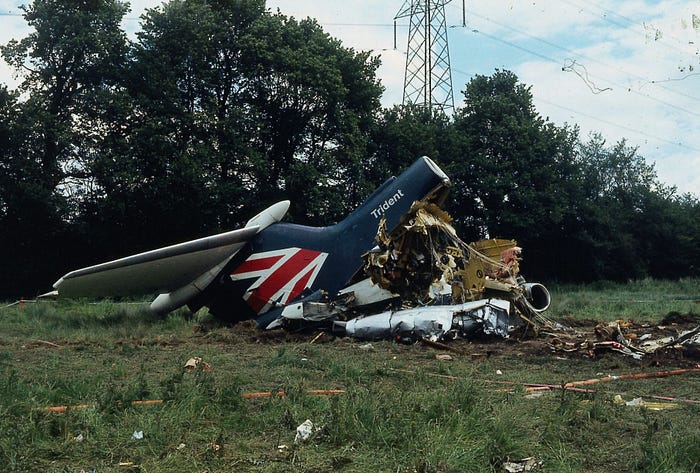
On the 18th of June 1972, British European Airways flight 548 took off from London’s Heathrow Airport, bound for Brussels. But just minutes into the flight, something went terribly wrong. The Hawker-Siddeley Trident stalled and fell from the sky, crashing to earth in a field in the quiet town of Staines; none of the 118 people on board survived. Although the public clamored for answers over what was then the deadliest plane crash on British soil, investigators had little evidence to work with. But there was plenty of intrigue: an old captain and young first officer; a critical lever pulled at the wrong time; a safety system overridden; a mysterious note making fun of the captain; a heated argument over a strike. After gathering all the evidence, investigators were faced with an unprecedented possibility: that the accident was indirectly linked to an ongoing union dispute at British European Airways.
In 1972, the airline we now know as British Airways had not yet been formed. In its place were two separate airlines: British Overseas Airways Corporation, which specialized in international long haul flights; and British European Airways, which operated shorter international routes within Europe. Among British European Airways’ fleet were numerous Hawker-Siddeley Trident medium range jets. The Trident was the pride of Britain’s domestic aerospace industry, and while it struggled to compete in some respects with the similarly designed Boeing 727, it was beloved by those who flew it.
At the time, British European Airways was experiencing significant turmoil in the workplace. Many younger pilots wanted to organize a strike to demand higher wages and better working conditions, while older, traditional pilots generally opposed the action. The proposed strike exposed a generational divide between those who viewed flying as a passion versus those who viewed it as a career. Lively arguments became commonplace. In 1972, some of the more experienced first officers took coordinated action, refusing to serve as observer pilots on training rides for new second officers being trained as flight engineers. At BEA, second officers on the Trident were trained to fulfil the roles of both copilot and flight engineer; with a lack of qualified first officers to observe them, however, many were stuck with only a copilot’s certification and couldn’t complete flight engineer training. This upset many captains, who preferred to have the copilot and flight engineer swap places after every flight, but were unable to do so when assigned second officers who were only partially qualified. At one point, a senior captain on a flight to Nicosia, Cyprus was assigned a crew that included an inexperienced second officer without flight engineer training, which would force him to fly in the copilot’s seat. The captain feared that bad weather could materialize near Nicosia and preferred a more experienced copilot to handle it. The captain asked the airline to change the roster, but was rebuffed; as a result, he became angry at the second officer, berating him and insinuating that he would be useless in an emergency. The second officer was so shaken by the encounter that he mistakenly deployed the flaps when he was supposed to retract them, and the flight engineer had to step in to reverse his input.
News of the Nicosia incident spread rapidly among pilots by word of mouth, fueling the ongoing generational conflict. One of the first to hear about it was one Second Officer Jeremy Keighley, a roommate of the second officer involved in the incident. Himself a second officer with incomplete flight engineer training, he would certainly have sympathized with his compatriot.
It was this same Jeremy Keighley who was assigned to the crew of British European Airways flight 548 from London to Brussels on the 18th of June 1972. Making up the rest of the cockpit crew were another second officer, Simon Ticehurst, who would act as flight engineer; and 51-year-old Stanley Key, an experienced Captain with over 15,000 flying hours. Stanley Key was known as one of the most ardent anti-strike old guard captains, and it had made him more than a few enemies at BEA. Unflattering rumors about him were passed among the younger pilots, and graffiti messages insulting Key had begun to crop up on tray tables at flight engineers’ stations on several of BEA’s Tridents. Whether Key was aware of the graffiti was an open question.

On the day of flight 548, Keighley and Key were both hanging out in the BEA crew lounge at Heathrow Airport along with several other pilots when an argument broke out. One First Officer Flavell is said to have asked Captain Key about the progress of his efforts to gather other senior captains in opposition to the strike, to which Key responded with a violent outburst, informing Flavell that this was confidential information, before transitioning to a loud, one-sided rant. The outburst didn’t last particularly long, but one witness described it as “the most violent argument he had ever heard.” Immediately afterward Key apologized to Flavell and they went their separate ways. One can only imagine the impression Keighley must have gotten from this incident, considering that he was about to fly with Captain Key for the first time.
Unknown to anyone, including Key himself, he suffered from atherosclerosis — a buildup of fatty tissue within major arteries that can restrict their diameter by 50–70%. While prosecuting the heated argument with Flavell, it is thought that Key suffered a blood pressure spike that caused weak blood vessels within the fatty buildup to burst, tearing open a piece of his arterial lining. Although he might not have noticed at first, the injury would have caused his level of pain to escalate noticeably as he finished pre-flight activities, boarded the Trident, and prepared for the flight to Brussels. Keighley and Ticehurst soon joined him in the cockpit, as did one Captain Collins, who would ride along as a passenger in the cockpit jump seat. Perhaps they made note of the graffiti, scrawled on the flight engineer’s tray table, proclaiming that “Key must go.”

After all 112 passengers and 6 crew had boarded the Trident, BEA flight 548 took off from Heathrow at 4:08 p.m. With Key as the pilot flying and the 22-year-old Keighley as pilot monitoring, the takeoff was initially normal, but that quickly began to change. Key commanded the autopilot to hold a speed 7 knots slower than normal, and their speed began to bleed off further throughout the climb.
To reduce noise over the London suburbs, planes climbing out of Heathrow were required to reduce engine power for a specified time beginning 90 seconds after takeoff. Authorities monitored the power reduction to make sure the timing was perfect, putting significant pressure on pilots to get it right. It is thought that Keighley would have been keeping track of the time until power reduction. Meanwhile, several radio calls took place in which Key responded tersely, leaving out required readbacks and other important information — perhaps due to his increasing pain. 93 seconds into the flight, Key reduced power for noise abatement and retracted the flaps, causing the speed to drop to 20 knots below the optimal 177-knot climb-out speed.

The way the rest of the climb procedure was supposed to work was that normal climb power would be restored at 3,000 feet, the pilots would accelerate to 225 knots, and then they would retract the droops. Droops, which are similar to slats, are control surfaces on the leading edges of the wings that can be extended to increase lift during low-speed flight. The position of the droops is controlled by a lever next to the throttles.
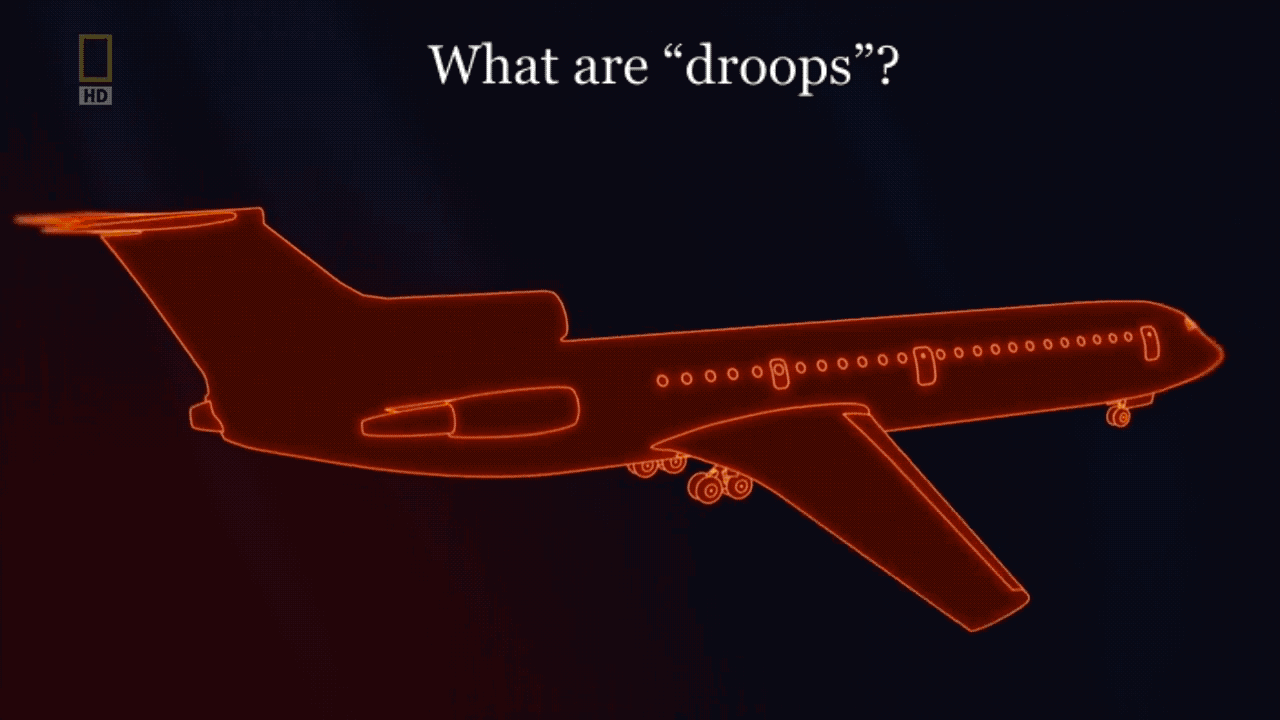
As the plane climbed through 1,770 feet at a speed of 162 knots (300km/h), Captain Key inexplicably pulled the lever to retract the droops. He did so at the worst possible time. Because the droops add lift, they decrease the speed at which the plane will stall, enabling flight at lower speeds. Retracting the droops increased the Trident’s stall speed by about 30 knots, which happened to put it above the actual speed of the plane. Flight 548 instantly entered a stalled state with no advance warning whatsoever. Within three seconds of the retraction of the droops, a cascade of alarms and warning lights suddenly filled the cockpit. The autopilot disconnected and the “stick shaker” alarm activated, physically shaking the pilots’ control columns to alert them to the stall. At the same time, a safety system called the stick pusher sprang into action, moving their control columns automatically toward nose down in order to increase the plane’s speed and escape the stall situation. The rapid-onset emergency took Key, Keighley, and Ticehurst completely by surprise.
Over the next several seconds, the stick pusher pushed the nose down two more times, until someone in the cockpit pulled the stick pusher override handle, disabling the system! Flying in cloud and apparently unaware that the droops were retracted, the pilots had decided that the stall warnings were false. The plane lost lift, stalled, and began to plummet out of the sky. No one took any action to recover, all three pilots sitting like deer in the headlights as the Trident dropped straight toward the village of Staines.
BEA flight 548 came in almost vertically and in a steep nose up position, narrowly missing a set of power lines before belly flopping into a field on the outskirts of town. The brutal crash shattered the plane into several pieces, leaving the tail sitting right at the point of impact, while the wreckage of the cabin tumbled forward a few meters before coming to rest in a tangled mass of metal and bodies.
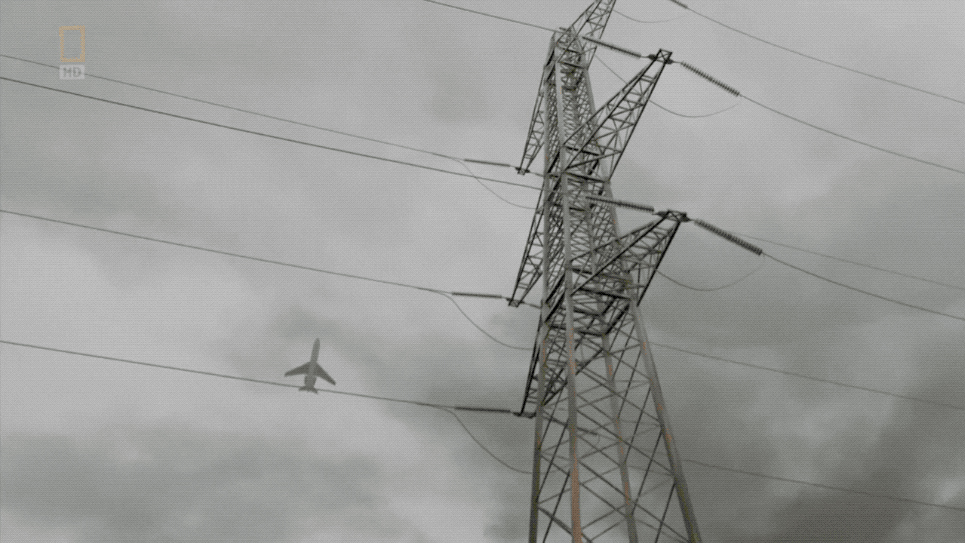
A boy who witnessed the crash rushed down the street to alert his neighbor, who was a trained nurse. The nurse was the first to arrive on the scene, where she found the partially intact fuselage full of passengers who had died instantly on impact. Searching through the tangled debris, she did manage to find one man who was still breathing, but his signs of life were weak and he was totally unresponsive. Shortly thereafter, emergency services arrived at the crash site and rushed him to hospital, but he soon died of his injuries, and no other survivors could be found. All 118 passengers and crew had been killed, making BEA flight 548 Britain’s deadliest plane crash ever at the time. (It has since been surpassed only by the Lockerbie Bombing in 1988.)

Investigators were faced with an immediate problem: the Trident had no cockpit voice recorder, and in fact under British law it was not required to have one. So while the flight data recorder made it apparent that the proximate cause was a premature retraction of the droops leading to a stall, figuring out why that happened would be extremely challenging. Several questions would need answers: which pilot retracted the droops; why did he do so; why did the pilots override the stall protection system; and why was the plane’s airspeed so low throughout the flight?
Forensic evidence at the crash scene indicated that Captain Key had been the pilot flying, making him responsible for the plane’s low speed. But why would such an experienced captain with no record of any previous incidents make such a basic mistake? This was of critical importance, since the plane would not have stalled upon retraction of the droops if it had been flying at the correct speed.
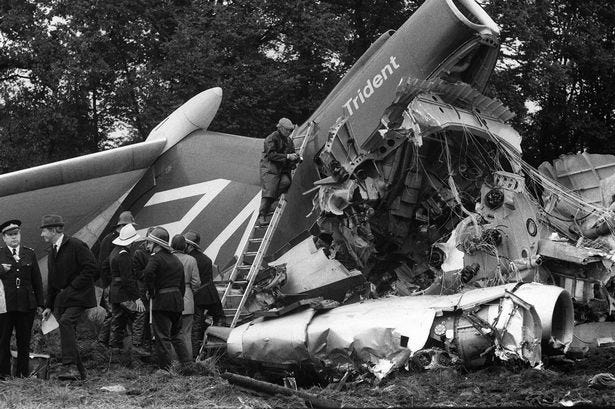
To everyone’s surprise, it was an autopsy of Captain Key that revealed a likely explanation. Expert analysis of his arteries showed that not only was he suffering from atherosclerosis, he had in fact suffered a delamination of the arterial lining due to a blood pressure spike sometime between one minute and two hours prior to death. Witness testimony showed that he had been engaged in a heated argument over the strike in the crew room some 90 minutes before the crash. Investigators determined that this was the most likely cause of the blood pressure strike that lead to the arterial injury. The general agreement was that this injury was unlikely to cause heart failure, death, or total incapacitation, but that it would have caused enough pain to interfere with Key’s ability to fly the plane, explaining both the abnormally low airspeed and his unusually terse radio calls. In his subtly incapacitated state, Key most likely retracted the droops while attempting to retract the flaps, which should indeed have been retracted at around that time and were operated by the lever adjacent to the droop lever. However, at that time the flaps had already been retracted (most likely by Second Officer Keighley).
Investigators also had to explain why Keighley and Ticehurst did nothing to counter the low airspeed, the retraction of the droops, or the stall. Ticehurst, being the flight engineer, was unlikely to have been able to intervene on principle. Keighley, while acting as the copilot, was very young, only had a couple dozen flying hours on the Trident, had just witnessed Key excoriate a first officer for very little reason at all, and was familiar with the Nicosia incident, making it very likely that he wanted to avoid crossing Key at all costs. Furthermore, it is possible that Keighley was distracted counting down the time to the noise abatement procedure, and that Ticehurst was distracted talking to the off-duty captain riding in the jump seat next to him. As for the retraction of the droops, assuming that it was in fact Key who retracted them, Keighley’s view of the lever might have been blocked by his armrest.
There was also a rational explanation for why the pilots failed to recover from the stall. When the stall occurred, it came on with unexpected suddenness. A “normal” stall occurs when the speed of an aircraft decreases past the stall speed, but this stall occurred when the stall speed itself suddenly increased past the speed the of the aircraft. This caused the stick shaker and the stick pusher to activate simultaneously, whereas normally there is a delay after the activation of the stick shaker, as the plane approaches its stall speed, before the stick pusher also kicks in. This is because the stick shaker is meant to activate several knots before reaching the stall speed, followed by the stick pusher once the stall speed is reached; however, in this case, the plane was not near the stall speed until the droops were retracted, at which point it instantaneously entered a stalled state. This special type of stall, colloquially known as a “change in configuration stall,” was not covered in training at any airline and the pilots likely had no idea that it could elicit unusual behavior from the stick pusher. Therefore, investigators concluded that the pilots probably thought the stick pusher itself was malfunctioning and pulled the emergency override handle to turn it off, allowing the airplane to stall.
There was indeed some evidence that Trident pilots considered the stick shaker and stick pusher to be unreliable. About half of known stick pusher activations on the Trident had been false, although none of those were in the six and a half years preceding the crash. Some pilots were said to believe that the stick pusher could come on by itself and dive the plane into the ground, although it was not in fact capable of doing this. This could have further contributed to the pilots’ immediate assumption that the stall warnings were false — there had been no change in the plane’s airspeed, the stick pusher behaved unusually, and pilot trust in the stick pusher was low. It was no surprise, then, that the pilots would have reacted incorrectly — and once the plane stalled, there was very little time to avert a catastrophic crash.
The discovery of the flight engineer’s tray table in the wreckage, complete with derogatory messages about Captain Key, forced investigators to also consider the possibility that there was some kind of conflict between the pilots during the flight. However, a handwriting analysis revealed that the messages were unlikely to have been written by anyone aboard flight 548. It was also possible to explain the crash without hypothesizing an argument on board, and investigators believed that none took place. But the conflict among pilots at British European Airways certainly contributed to a cockpit atmosphere that perhaps lacked the level of coordination and teamwork that was expected. Mutual distrust between older pilots like Key and younger pilots like Keighley created a company culture where pilots felt they couldn’t rely on one another. Keighley was especially vulnerable because he felt he couldn’t rely on himself either. Those who trained him testified that he would have been a good pilot eventually, but that he was slow to learn and doubted his abilities; he excelled at rote tasks but was slow to react in emergencies and lacked initiative. As a result, the burden of responding to the emergency fell squarely on Captain Key, who was at that time medically unfit for flight.
Having established what happened, investigators now asked: could the crash have been prevented? The answer was — well, maybe. Experts agreed that no doctor was likely to have flagged Key’s cardiovascular system as deficient prior to the injury he suffered on the day of the crash. However, regarding operational factors, investigators found evidence that the danger was already known. In 1970, in what was referred to as the “Foxtrot Hotel incident,” the exact same sequence of events nearly happened to another BEA Trident. The pilots claimed that the droops retracted by themselves, setting off the stick shaker and stick pusher simultaneously. Fortunately, the pilots noticed that the droops had retracted and were able to prevent the plane from stalling. However, despite the pilots’ insistence that a mechanical failure had occurred, no problems with the droop system could be found. Investigators in that case believed that the captain had in fact retracted the flaps shortly after takeoff to improve climb performance (a violation of standard operating procedures), forgot that he had done so, and then accidentally retracted the droops when attempting to retract the flaps later. The Accidents Investigation Branch (AIB) didn’t look too deeply into the crew’s actions because the agency didn’t want to damage its working relationship with the British Air Line Pilots Association.
Subsequent to the Foxtrot Hotel incident, the same captain was flying out of Orly Airport in Paris when he retracted the droops too early. Once again, he had retracted the flaps early in the climb, forgotten, and then moved the droop lever when attempting to retract the flaps later. However, he had apparently gained such a reputation for doing this that the first officer was watching him closely and immediately pushed the nose down to avoid the activation of the stick shaker and stick pusher. But the first officer never formally reported the incident for fear of getting the captain in trouble.

Unfortunately, several attempts to raise the alarm about these two incidents had gone unheeded. BEA’s General Manager of Flight Operations had called for the Foxtrot Hotel investigation to be reopened because he feared a major accident due to a pilot retracting the droops too early. But this was not done. Another captain had also warned the airline that many pilots automatically assumed that a stick pusher activation was due to a malfunction of the stick pusher rather than a stall. However, this captain had a reputation for reporting problems constantly — like the boy who cried wolf, when he finally pointed out a real problem, he was ignored.
Research into pilot incapacitation also should have set off alarm bells in the industry. Crewmembers are expected to notice when the captain becomes incapacitated, even subtly. But simulator tests in the United States in 1971 showed that 25% of instances where the captain was unexpectedly incapacitated on takeoff or landing ended in a crash. In the remaining 75%, the other crew members required anywhere from 30 seconds to four minutes to notice and react. This deeply undermined the assumption that the incapacitation of the captain would be obvious to the rest of the crew, and perhaps new training in the area should have been considered. At that time, training related to pilot incapacitation didn’t extend beyond the obvious total collapse of the captain.
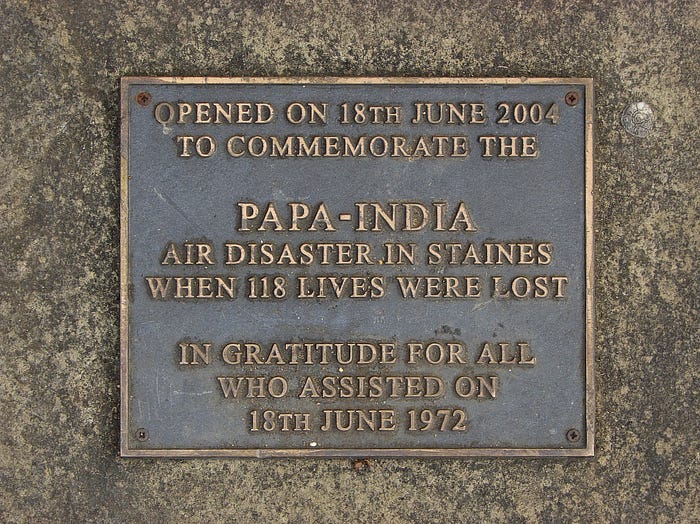
In its final report, the AIB issued a number of recommendations intended to prevent a similar accident from ever happening again. These included that a baulk be installed to prevent the droop lever from moving to the retracted position if the plane’s speed is too low; that pilots be trained on change of configuration stalls and how they affect the stick shaker and stick pusher; that pilots be trained to recognize even subtle incapacitation of other crewmembers; that trainee pilots receive more flight deck experience before being allowed to fly unsupervised; that the cockpit jump seat should be unoccupied during critical stages of flight; and that BEA give its head of safety more authority, among other suggestions. And perhaps most importantly, the AIB recommended that all British aircraft carry cockpit voice recorders, something that had been required in the US and Australia for years, but was not yet mandatory in Britain. In a frank assessment of its own capabilities, the AIB noted that without a cockpit voice recorder, they could not say with any certainty whether their analysis of the crew’s actions was correct, and that had a recorder been installed, it might have sent them down a completely different line of inquiry. Was there an argument on board? Did Captain Key see the graffiti? Did anyone attempt to warn Key that his speed was too low? Unfortunately, we will never know the answers to these questions. But as a result of this recommendation, cockpit voice recorders were mandated on all British airliners for the first time. Never again would an investigation into a plane crash on British soil be forced to make do with so little.
_______________________________________________________
Join the discussion of this article on Reddit!
And don’t forget to visit r/admiralcloudberg, where you can read over 120 similar articles.
